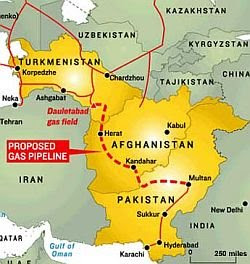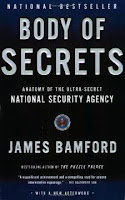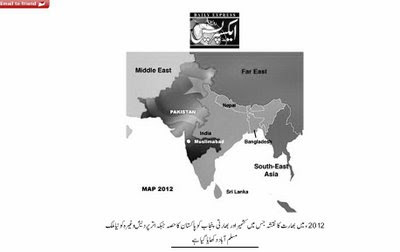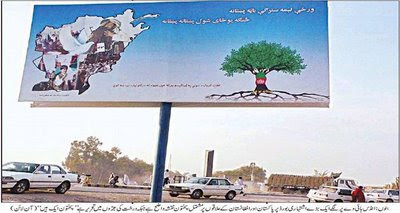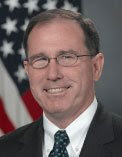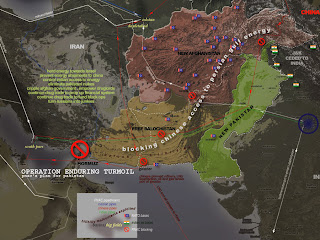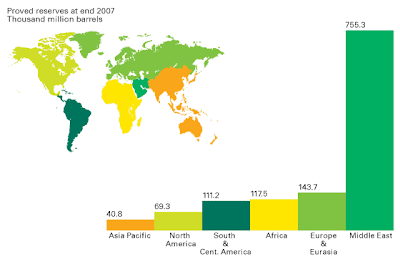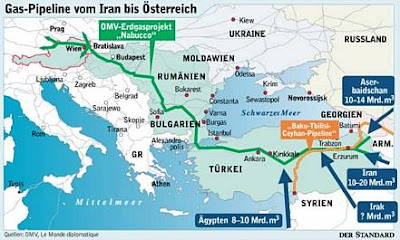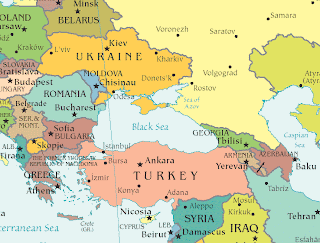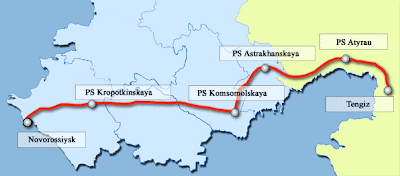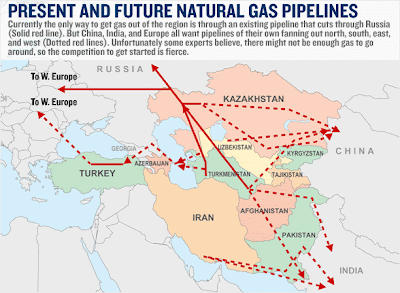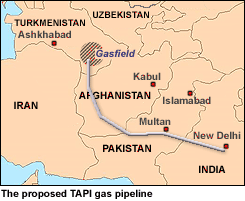Nothing and no one is allowed from distracting it from that goal.
I am sorry if it sounds repititous to some of the readers but I cannot emphaisize enough that USA can deal with the devil to get business deals in its favour - let us once again cast back to the point when Taliban was in control of Afghanistan:
The then US Assistant Secy of State for South Asian Affairs, ROBIN RAPHAEL went on to state – “The Taliban capture of Kabul is a POSITIVE STEP.”
Another senior US Diplomat stated : “The Taliban will probably develop like the Saudis did. There will be Aramco, pipelines, an Emir, no parliament and lots of shari’a law. We can live with that.”
On December 4th 1997, the representatives of Taliban were invited guests at the Texas headquarters of UNOCAL to negotiate support for the pipeline.
Chevron even had a tanker named "Condoleeza Rice".
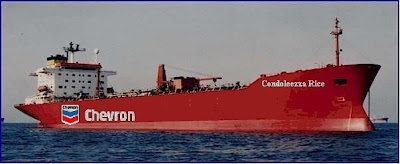
In Condi and the boys, Russel Baker states: "George Shultz, who was on the board of Chevron, introduced her to Chevron's chairman and CEO, who took her to lunch and, Shultz said, "inside of fifteen minutes concluded that she would make a terrific board member." She was a good choice. Chevron was engaged in a $10 billion oil-field development project with Kazakhstan, and Rice, who happened to know its president, traveled to Kazakhstan for Chevron in 1992. She turned thirty-eight years old that year. In the following year Chevron named a 129,000-ton supertanker the SS Condoleezza Rice."
Dick Cheney and Rumsfeld wanted to sell US Nuclear Reactors to IRAN in 1976 - and now in 2008 they want to bomb "suspected" nuclear reactors.
The greed to give US Nuclear Reactors to Iran - a country flush in natural oil & gas will need a new defition for the word "greed".
Nothing has changed today - the greed for Central Asian Gas has only increased fuelled by the fast US descent into the vortex of economic doom which happens when empires are built on debt of citizens to fund future consumption and investment bankers who demand that avarice should have been their middle name.
BOMBERS FOR RENT:
Pakistan is a failed state, not in control of vast swathes of territories. Human bombs are available dime to a dozen to blow off any adversary for the right price.
As long as this was localised one could have swept them off - but these terror outfits have become very powerful and as I have said before, I will repeat it here:
PAKISTAN MILITARY IS THE NEW TALIBAN / TERROR FACTORY:
Pakistan Army uses its planned "deserters" and even its current cadres to infiltrate terror groups like Laskhar e Taiba (LeT), Jaish e Mohammad (JeM), Lashkar e Jhangvi (LeJ) - the group responsible for the Marriott blasts and run by Omar Sheikh from his prison "cell", the "various" Taliban cells.
Let us look at just 4 incidents:
1. Taliban leader killed by British SAS troops in Hemland (Afghanistan) was a Pakistan officer (with military ID in his body)
2. Major General (r) Amir Faisal Alvi was shot dead along with his driver on the outskirts of the capital on November 19, 2008. Schofield says Alvi, who had commanded the elite Special Services Group, gave her a copy of a letter he had had sent to army chief General Ashfaq Kayani in which he named two generals whose conspiracy resulted in his premature retirement more than two years ago. The British journalist said Alvi gave her a copy of the letter four days before he was killed, and had asked her to publish it in the event of his death. She said Alvi expected to be killed, as he had not received any response to his letter.
Alvi believed he had been forced out of the army because he had become openly critical of deals between Pakistani generals and the Taliban.
3. On the eve of the last phase of polling in Jammu and Kashmir, police today said they had foiled a Jaish-e-Mohammed plan to carry out suicide attacks in Jammu city with the arrest of three persons, including a serving soldier of the Pakistan Army.Ghulam Farid is from 10 AK (Azad Kashmir) Regiment, Jammu and Kashmir police chief Kuldeep Khoda said, and the release gave the belt number as 4319184. Khoda said Farid had joined the army in 2001 and was “deputed” to work with Jaish in 2005.
4. NOV 2001: Taliban besieged in Kunduz by Norther Alliance force. But wait : Pakistan got US approval to airlift Pakistani soldiers embedded with the Taliban. Among those evacuated were : two officers, both of brigadier rank, were said to be part of 1,000-strong regular Pakistani army men trapped in Kunduz and were directing Taliban fighters in Kunduz and in Mazar-e-Sharif, the sources said.
By this time, there should be NO AMBIGUITY about Pakistan Army role in arming the terror units and the Taliban for its own covert / overt operations in foreign shores.
But wait a minute and look at two other incidents related to points 1 & 4 above:
On point 1 - Britain’s refusal to make the incident public led to a row with the Afghan president Hamid Karzai, who has long accused London of viewing Afghanistan through the eyes of Pakistani military intelligence, which is widely believed to have been helping the Taliban.
PAKISTAN BLACKMAILS THE UNITED NATIONS:
In the same article in The Sunday Times (UK) it states: "The Afghan claims of Pakistani involvement in Helmand were backed by a senior United Nations official who said he had been told by his superiors to keep quiet after Pakistan’s ambassador to the UN apparently threatened to stop contributing forces to peacekeeping missions. Pakistan is the UN’s biggest supplier of peacekeeping troops."
Pakistan blackmails the NATO/US that if India does not tone down the "rhetoric", it will move it soldiers from Afghan border to the Indian border. Pakistan blackmails India with the "nuclear threat"
PAKISTAN IS NOT ONLY "TERRORISTAN", IT USES BLACKMAILING AS STOCK FOREIGN POLICY TOOL.
On point 4 - USA gave Pakistan overflight rights to evacuate its soldiers trapped.
Hence : UK & US are not going to do anything to endanger their relations with the Pakistan Army. Even if Pakistan Army is guilty of the Mumbai terror - will the USA / UK / NATO come down hard on Pakistan Army?
The answer is an unequivocal NO.
If some of you are still on the fence, let me showcase this. The attacks on Twin towers - better known as 9/11 - showed complicity of Pakistan and ISI - at the highest levels. Curiously in the final 9/11 commission report the damaging references to Pakistan and ISI are missing.
WHY ? Did US get a chance to invade Afghanistan that gave it a base to be at the theatre of Central Asian gas hence a trade off was reached with Pakistan?
The US / UK / NATO all know the Talibalisation of Pakistan - yet US & UK keep an ambivalence about the issue. In fact from time to time, it asks India to show restraint when it did not take US an UN mandate to attack Iraq or Afghanistan.
By this time, we should get a clear idea on what US & UK are all about - and the reason it keeps shifting goal posts for India.
Taking some paragraphs from my previous post:

1. India planned to attack at terrorist camps surgically. With most of the camps emptied out, these strikes would have been only symbolic. The aggressive stance of Pranab Mukherjee and the submissive stance of Manmohan Singh is calibrated to fit the proverbial "bad cop good cop" game theorizing. Indian elections are due in 2009 and if the Congress party is not seen to do anything, then their election prospects will be "doomed". Notice, how AR Antulay keeps his job, just to pander to "vote bank politics"

2. India asked USA to get Pakistan's approval for the surgical strikes, so that Pakistan does not retaliate. It is precisely for this reason Adm. Mike Mullen went to Pakistan to ask Pakistan to lay low when India strikes at terrorist training camps of LeT and others in Pakistan Occupied Kashmir (POK) and near Lahore. It seems the civilian government gave its nod for "limited" Indian attacks in POK but not in mainland Pakistan, which includes areas near Lahore.

3. Mike Mullen "fails" (CONVENIENTLY) in this as COAS Kiyani made it clear that regardless of how the civilan government chooses to respond to the US request to allow Indian 'surgical strikes’, Pakistan Army will not accept any Indian intrusion. The scrambling of jets over Lahore and Islamabad was part of this and the armed forces are alert and ready to defend against any Indian action.
Kiyani is also said to have told US Michael Mullen that in event of any aggression from India, the US and NATO can ‘forget about’ using Pakistan territory to supply their forces in Afghanistan as all resources will be diverted to defending against India on the eastern border.Mike Mullen tells India, he fails in his effort.
General Rtd. Aslam Baig has said that US General Mullen is pressing our authorities to allow India to hit certain targets, keeping silent and indifferent to the situation as they have been doing in case of US attacks, which he believes, will cool down India and diffuse tensions between the two countries.
“I don’t think that conscientious Pakistani nation and brave armed forces of Pakistan will accept such a situation. This will be shameful and render Pakistan's submissiveness to India,” the retired General said.
He called upon the rulers to explain their position in this regard. He said that the US was after ridiculing the sovereignty of Pakistan only to please India and Mullen had come with a dangerous message.
4. A chastened Pranab Mukherjee lashes out at US & UK for NOT doing enough. (meaning US & UK not getting Pakistan's permission to get bombed in POK).
With elections looming around the corner, and USA not getting the go ahead from Pakistan authorizing Indian strikes on terror camps, what next? Pranab Mukherjee (India's Foreign Minister) is fast running out of options and his verbal threats are increasingly looking like posturing on empty.
ADDITIONAL COMMENTS FOR THIS POST:
While Pranab Mukherjee is flailing his arms about, Islamabad seems to have concluded that the US pressure had all but run its course. Actually, by gently holding out the threat to the US that the Afghan operations would grievously suffer unless Washington restrained Delhi from precipitating any tensions on the India-Pakistan border, Islamabad seems to have neatly pole-vaulted over Rice to appeal straight to the Pentagon, where there is abiding camaraderie towards the Pakistani generals. (NOTE: PENTAGON HAS ALWAYS HAD A SOFT CORNER FOR PAKISTANI GENERALS AND LIKES DEALING WITH THEM)
The Pakistani generals' calculation proved correct when the Pentagon made it abundantly clear to Delhi that it wouldn't allow the Pakistani generals to be "distracted" at this juncture.
Speaking from Camp Eggers in Afghanistan on December 20, Admiral Mike Mullen, chairman of the US Joint Chiefs of Staff, laid down the ground rules for India. (WOW - LAYING DOWN THE GROUND RULES FOR INDIA - IMAGINE THAT!)
He said the overarching strategy for success in Afghanistan must be regional in focus and include not just Afghanistan, but also Pakistan and India. Continuing in this seemingly innocuous vein, Mullen explained that the three countries must "figure a way" to decrease tensions between them and the "regional strategy" here is aimed at addressing long-term problems that increase instability in the region.
Mullen then referred specifically to Kashmir as a problem where reduction of tensions "allowed the Pakistani leadership ... to focus on the west [border with Afghanistan]".
He expressed apprehension that the terror attack in Mumbai might "force the Pak leadership to lose interest in the west", apart from bringing India and Pakistan closer to a nuclear flashpoint. Curiously, Mullen gave credit to the Pakistani top brass for cooperation in the Afghan war, which "has had a positive impact" on the ground.
USA ADDING INSULT TO INJURY:
Significantly, amid all the fracas over the Mumbai attacks and despite repeated Indian calls to isolate Pakistan in the world community as the "epicenter" of terrorism, Washington is quietly putting together a new multi-billion dollar aid package for Pakistan, and CENTCOM is drawing up a new five-year plan committing $300 million assistance annually to the Pakistani military.
Kerry, while on a recent visit to Islamabad, made the commitment to speed up the "mid-life upgradation" of Pakistan's F-16 aircraft capable for delivering nuclear weapons. He said the US considered a "vibrant, strong, economically viable" Pakistan to be "vital for peace and stability in South Asia".
The last big dole that USA gave Pakistan was $11 billion to fight the war on terror and Pakistan used that to buy military hardware to fight India instead. Most of the military harware was sold by US and it was therefore complicit in this purchase. The idea was simple - bring some "parity" to Pakistan Army's arsenal to stop India getting advenurous.
USA still harbours deep suspicions about India's connections with Russia and Iran and it wants to keep India / Russia and China out of Central Asian Regions.
INDIA SHORTCHANGED:
Kashmir elections and high voter turnout has given India the "moral right" to be strong on the Kashmir issue much to the chagrin of Pakistan and dare I add, even USA.
This is India's war, India's moment.
2009 is election year in India and Afghanistan and there is a new Obama administration coming into USA. More reasons to create muddle in this transition phase. India has to rise above the Great Game and realize that this is the right moment. Economic realities have given an opening that should be seized.
Any more dithering, and we will be the laughing stock of the entire world.
US loves dealing with strong people / personalities / nations - does not matter if they are dictators / killers as long as they help US. And US abhors weak kneed nations and people - hence INDIA will time and again will be shunted around if we show weakness as we are doing now and have in the past.
Remember Indira Gandhi and how we won the war inspite of the US bringing its naval aircraft carrier. We are sadly missing her today.
At the very least India should:
1. Turn off water from CHENAB (which is in Himachal and far from the reach of Pak Air force) into Pakistan. Why are we not using our water advantage over Pakistan?
2. Bring Kasav on TV to appeal to his parents, his friends and discuss about the terror camps. An appearance on TV will change a lot of dynamics within Pakistan.
US is not the enemy here but due to her obsession with "profits" it loses interest in the spillover effect it might have on the neighbouring countries where it deems its interest to be at. Unfortunately, US looks at terror through the lens of what affects it (hence Al Qaeda, Taliban are bad) and others that do not (Lashkar e Taiba etc).
If we sit in our post-colonial "biggest democacy" stupour and base the "so-called" success of Nuclear Deal authoured by the US and then expect that USA will come and help cleanse TERRORISTAN for INDIA - well, we should NOT AT ALL entertain such "childish" notions ANY LONGER.
We have lost PAKISTAN to TERRORISTAN. The faster we neutralize this menace OURSELVES, the lesser the pain we have to endure. Carry on the diplomatic offensive to tell the world the real story - but do not expect any help in return, other than verbal platitudes that mean nothing.
If not for us, our children deserve a better future and in a better world.

